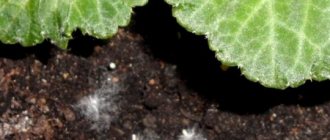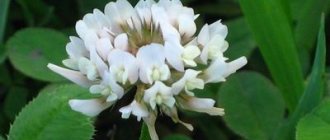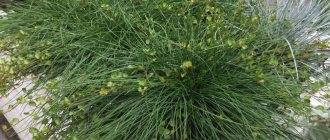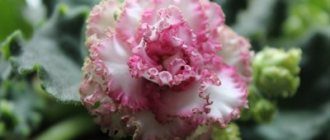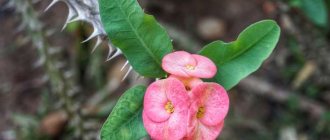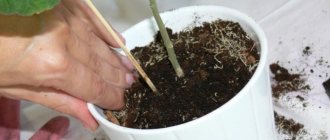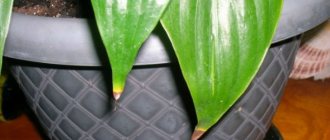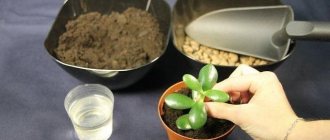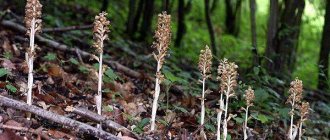Owners of personal plots strive to plant them in accordance with all the rules of landscape design. It's nice to go out into the yard, covered with a natural green carpet. After sowing lawn grass, people are often disappointed because without proper care the sowing does not look aesthetically pleasing. Not everyone knows that you can use white clover for the lawn as the most low-maintenance plant, so let’s look at the features, advantages and disadvantages of the crop, how to plant and maintain a beautiful lawn.
Clover lawn Source woodstar.com.ua
Characteristics
This is a common low-growing plant with creeping stems and branching roots. The branch has three leaves with white streaks. Belongs to the legume family. Since spring, the earth is covered with an elegant bright green carpet. In summer, white flowers appear, which are inflorescences of many small tubular flowers.
During flowering, clover is covered with white fluffy inflorescences Source dary-prirody.su
An unpretentious meadow plant grows throughout Russia. The branched roots go to a depth of 250 cm. The basal system contains buds, which protects the bush from being eaten by animals. Thanks to the activity of bacteria that absorb nitrogen, small tubers appear on the roots. This is the result of a natural symbiosis, as a result of which the plant receives nitrogen from the air and processes it into an easily digestible form.
The perennial is unpretentious to the soil - it grows well both on fertile black soil and on aluminous soil. It does not require frequent watering, it spreads on the surface as a continuous carpet, without forming bald spots, unlike lawn grass.
It blooms twice a year, but blooms for the first time in the second year after sowing the seeds. The first series of flowering occurs from May to August, the second - from August to October.
Preparation of the plant and use in folk medicine
For medicinal purposes, you can use all parts of the plant - flower heads, stems and leaves themselves. It is during flowering that grass and flowers are collected, containing the glycosides trifolin and isotrifolin, essential and fatty oils, vitamin C and other useful substances. The leaves and stems also contain significant amounts of vitamin C, carotene, and contain xanthine, hypoxanthine and adenine.
After collection, the grass is sorted, removing limp, darkened, rotten parts. You can dry it both in the open air and in a ventilated room, but always without access to sunlight, spreading the raw materials freely and lushly to ensure the penetration of air into it. During the drying period, the grass must be turned over and loosened at least once a day so that it does not become damp.
Finished dry raw materials are used within one year . A variety of decoctions, water and alcohol infusions are made from it for external and internal use.
Having a valuable chemical composition, white clover has long been known in folk medicine and is used for medicinal purposes as a tonic, hemostatic, wound-healing, and disinfectant. It is used for anemia, whooping cough, chronic cough, colds and other pulmonary diseases, painful periods, other female diseases, hemorrhoids, tuberculosis, gout, as an expectorant, weak diuretic. For abscesses and burns , inflammatory processes of the ears and eyes, a decoction is prepared for external use. White clover is an excellent raw material for making C-vitamin infusions.
To treat various diseases, you should follow the dosages indicated in the recipe - decoctions or infusions are drunk as tea or in tablespoons.
Fresh clover is also used , making a paste from the leaves and stems. Compresses from such a pulp help cure abscesses, tumors, bleeding wounds, reduce hemorrhoids and inflammatory processes. The fresh juice of the plant is also an excellent remedy for wounds.
Despite many very useful properties, the plant also has contraindications, which should not be forgotten.
Main contraindications
- during pregnancy,
- with thrombophlebitis,
- strokes,
- heart attacks,
- serious heart disease
Creeping clover is used not only for medicinal purposes, but even in cooking. Dried flowers of the plant are used as a seasoning for soups and other dishes, young leaves are added to salads, dry and floured leaves are added to bread , which is considered dietary.
White clover
Varieties of white clover
Botanists have developed a large number of plant varieties: Volat, Pipolina, Klondike, Dukhmyany, Ronnie, Sylvester, Rivendell. With such an abundance of varieties, you have to decide which clover to choose for your lawn in order to spend less time on care.
A decorative variety of microclover creates a continuous green carpet Source sadrium.ru
Decorative microclover is gaining popularity thanks to:
- drought resistance;
- elegant evergreen cover;
- strong roots that ensure high growth - there are almost no bald spots, as they quickly overgrow.
Application
The creeping plant has proven itself well for seasonal colds, as a general strengthening and tonic.
It is also used for pulmonary tuberculosis, gynecological pathologies, imbalance of the body’s salt balance, and general weakness after any illness. In addition to therapeutic purposes, clover is widely used in cooking. As an addition to soups, salads and cuts, this is an excellent solution for an everyday menu. It supplies nutrients and vitamins unchanged directly with food.
vote
Article rating
Why is white clover good for the lawn?
"White porridge" is widely used in landscape design. The planting quickly forms a fluffy emerald carpet decorating the area. The lawn is pleasing to the eye, suitable for relaxation, and children can frolic on it. Planting is used for:
- designing borders and circles around trees;
- sowing the space between the beds and paths in the garden;
- sowing between stone slabs;
- creating lawns;
- lawns.
Edging a garden path Source lifegazon.ru
See also: Catalog of companies that specialize in landscape design
Next, let's take a closer look at the pros and cons of a clover lawn:
Positive sides
The culture is popular among gardeners due to the following advantages:
- decorative – planting creates a bright green flooring, enlivened by white color during flowering;
- pleasant soft surface - it’s pleasant to walk on the green carpet without shoes;
- does not require frequent watering, tolerates dry periods well;
- resistance to trampling;
- does not require fertilizers, as it is a soil-improving crop. After harvesting, you can grow vegetables;
- not afraid of frost;
- cut grass can be used as animal feed;
- flowers serve as a source of nectar for bees;
- a dense root system prevents the growth of weeds;
- fixes the soil;
- inexpensive price;
- perennial crop - no need to plant it every year, just add seeds to the soil once and maintain the appearance by mowing and watering;
- grows on any soil;
- quickly restores appearance after mowing;
- universal – suitable for creating both large and small lawns;
- good compatibility with rock gardens, fountains, rose gardens, and various flower beds.
Bees flock to flowers Source lifehelper.one
Flaws
Lawn clover has some disadvantages:
- the need to remove dead inflorescences to give an aesthetic appearance, since after flowering the lawn looks unattractive;
- Care should be taken when walking after watering or rain, as wet turf slips;
- the attractiveness of flowers to bees can be a disadvantage for those with small children;
- rapid growth can cause crowding out of garden crops, so it is necessary to fence the plantings;
- immediately after mowing, the lawn does not look aesthetically pleasing;
- timely trimming is required, as large grass breeds slugs and snails;
- tubers attract various pests, for example, click beetles, so you should not arrange a lawn near garden crops.
When creating a lawn from white clover, the pros and cons must be taken into account so as not to be disappointed with the result.
Advantages and disadvantages
The popularity of clover lawn is explained by its obvious advantages over other types. Among the main advantages:
- low maintenance requirements;
- resistance to trampling;
- immunity to diseases and pests;
- high seed germination;
- soil enrichment with nitrogen;
- rapid growth after sowing;
- decorativeness;
- low cost of seeds;
- loyal attitude to haircut.
There are also disadvantages:
- cut grass takes a long time to dry;
- attracts bumblebees and bees during flowering;
- seeds can be spread throughout the area and multiply by self-sowing.
Reproduction
Clover "White Porridge" is propagated in two ways: seeds and shoots. The seeds are easy to collect yourself:
- To do this, large faded inflorescences are picked;
- select seeds from the husk;
- laid out in one layer and dried in a dry place protected from the sun.
The dried seeds are placed in a cloth bag or paper bag.
You can collect clover seeds yourself Source nuttygrass.files.wordpress.com
How to plant Dutch clover
Dutch clover is one of the most common varieties of this plant, from which many varieties have been developed.
Clover should be planted at a temperature not lower than 10°C. This can be done from the beginning of May until the end of September.
In order for your clover lawn to look smooth and neat, you need to follow a few simple planting rules:
- If there was no rain shortly before sowing time and the soil is dry, then it should be well watered the day before.
- The seeds need to be deepened into the ground 1 - 2 centimeters.
- After sowing, you need to trample the soil so that the white clover seeds sprout evenly.
Making a lawn out of white clover
An unpretentious, fast-growing plant ideal for landscaping. It is enough to plant the seeds once and you will enjoy your lawn for many years. Seeds are planted in late winter so that they do not have time to swell and sprout. They will overwinter in the soil and germinate in the spring. You should take into account the fact that almost half of the seedlings will die, so take twice as much seed material.
You can plant at the end of August - the seeds will have time to germinate and take root before the onset of cold weather.
Spring planting is preferred, including several methods:
- ordinary - seeds are placed in prepared grooves in the soil to a depth of 1.5 cm and watered;
- on the ice crust - the method consists of scattering grains on the snow floor. After the snow melts, they will fall into the ground and germinate;
- seeds mixed with sand are scattered on the ground. By the light spots you can find out where the seed material ended up.
Stores sell seeds ready for planting. After reading the instructions, you can easily plant. One hundred square meters will require from 2.5 kg to 3.0 kg of seeds.
Seeds are sold in packaging, with sowing instructions on the label Source cdn1.ozone.ru
The crop is sown in April-May, when the temperature rises to +10-13 degrees. To prevent your lawn from causing problems with abundantly overgrown weeds, treat the area with a herbicide. Work begins with digging up the soil. Next, you need to clear the area of weed roots, compact the soil with a roller and level the surface.
The plant does not grow well in acidic soil. In this case, it is necessary to add dolomite flour or lime to the ground. Seeds can be planted using one of the above methods. Mix the seed with sand and spread evenly over the moistened area. Cover the top with a layer of peat and soil. It is not recommended to plant deeply - up to 1 cm on light soils, up to 0.5 cm on heavy soils.
The crops must be watered abundantly. It is better to do this using a hose with a sprinkler so as not to wash away the top layer of soil. The first shoots will appear in a week. Increased watering leads to the appearance of fungal diseases.
You can renew your lawn every five years by sowing seeds.
Morphology
Creeping clover seedlings are distinguished by an underdeveloped, thin subcotyledon part. The epicotyledonous internode is undeveloped. The cotyledons are oval with a rounded apex, on short petioles. Cotyledon dimensions: 3 – 4 x 1.5 – 2 mm. Petioles – 2 – 3 mm.
The first leaves are arranged alternately. The first one is wide-rounded. The top has a small notch. The edge is slightly wavy, without pubescence. Length and width 4 mm. Petiole – 15 – 20 mm. The middle, closer to the base, has small specks of dark brown color.
The second leaf is trifoliate with obovate, slightly notched leaflets at the tips. The surface is without pubescence. There are 3-4 small cloves on the sides of the leaf.
In the center there are scattered dark brown spots. Petiole long
The third leaf is similar in morphology to the second. (Vasilchenko I.T., 1965)
An adult plant develops a powerful, multi-headed, branching taproot. The bulk of the roots develop at a depth of 40–50 cm, some up to 1 m. The main stem of the plant is small, up to 4 cm high, without a flower head. The lateral stems and shoots are creeping, highly branched, up to 60 cm long, root at the nodes, forming a creeping bush of considerable size. Stems without pubescence. The leaves are on long, up to 30 cm long ascending petioles, trifoliate. The leaves are on short petioles, obovate, notched, 1–3 cm long. The width is slightly less than the length. Leaf surface with numerous non-prominent forked-branched lateral veins. The edge of the leaf is finely toothed. (Medvedev P.F., 1981) (Komarov V.L., 1945)
The inflorescence is represented by a spherical head, up to 1.2 cm in diameter, with 30–80 flowers. The corollas are white, cream or light pink. When flowering occurs, the heads turn brown and deviate downward. (Medvedev P.F., 1981) (Gubanov I.A., 2003)
The fruits are linear, oblong, three to five seeded beans with a thin leathery pericarp. Bob length – 5 – 6 mm.
The seeds are compressed, heart-shaped and oval. The surface of the seed is smooth, matte or slightly shiny, yellow, reddish or light brown. Seed dimensions: 1 – 1.5 x 0.75 – 1.25 x 0.5 – 0.75 mm. Weight of 1000 pieces – 0.5 – 0.75 g (Dobrokhotov V.N., 1961)
Proper care is the key to a beautiful lawn
The lawn does not require special care, but it looks better if you water it once a week and mow it after flowering. In dry weather, watering is increased more often. If you have not treated the area with herbicides, you will have to remove the weeds by hand.
A haircut
Tall plant thickets encourage the appearance of slugs and snails. Therefore, after flowering, a haircut is required.
Mowing with a lawnmower Source fermer.blog
A lawn with clover will acquire an aesthetic appearance, and flowering will increase. Destroying flowers prevents the development of seeds and the growth of the crop. In the first year, the planting is not cut. The next year after planting, when the plant grows, it will require pruning.
Fertilizer
Before planting, humus is added to the soil. Potassium-phosphorus fertilizing is done once every two months. To give a better look, skinny plants are sprayed with boron fertilizers.
Definition
Creeping clover is a weedy perennial taproot plant. The stem is ascending, erect or recumbent. Height up to 60 cm. Surface without pubescence. The leaves consist of three small leaflets. The petioles are long. Stipules are finely pointed, lanceolate or ovate.
The inflorescence is a spherical head on a peduncle. The corollas are pale pink, often white. The fruit is a linear, oblong, three- to five-seeded bean. The seeds are heart-shaped, oval, compressed, yellow, red-brown or reddish. Blooms in April - September, bears fruit in July - October. The species is distributed almost everywhere in Eurasia, and is known as an alien or introduced species in many temperate regions on other continents. (Trukhachev V.I., 2006) (Medvedev P.F., 1981) (Dobrokhotov V.N., 1961) (Gubanov I.A., 2003)
Pest Control
With high humidity, the plant is susceptible to infection with fungal diseases: rust, fusarium, ascochyta blight, anthracnose, brown spot. As soon as the first symptoms of the disease appear, the plantings must be sprayed with a 1% solution of colloidal sulfur. After 10 days, the procedure is repeated. You can pollinate with slaked lime or sulfur powder.
The dodder wraps around the stem and feeds on the sap of the plant Source kccc.ru
Diseases and pests
Red clover: description, properties and application
The clover planting looks very thick, and it is because of this that the soil under it does not have time to dry out, which contributes to the formation of high humidity. This leads to snails and slugs and is also the reason why clover is susceptible to fungal diseases. For prevention, regular haircuts are carried out.
Clover diseases
In addition to snails and slugs, other insects can cause damage to the plant:
- Alfalfa bug. To combat this parasite, insecticides are used during the period of budding. This is important, since at this time the insect lays larvae, which will also be destroyed.
- Clover weevil. To prevent its appearance, clover seeds are also treated with insecticides.
- Locusts. Such pests cause enormous damage to plants of various crops, especially the Siberian and dark-winged locusts and grasshoppers. The method of control is the same preventive treatment with insecticides.
clover weevil
Among the dangerous diseases, clover can be affected by powdery mildew, to prevent which you need to thoroughly clean, sort and properly store the seeds, and pickle them before sowing. Do not forget about fertilizing in the form of phosphorus and potassium fertilizers.
The nuances of planting clover
Experts on growing clover give advice:
- do not push the seeds too deep into the ground;
- when planting in a dark place, double the number of seeds;
- It is better to plant a clover lawn on the sunny side so that it grows well;
- To prevent the plant from spreading beyond the lawn, surround it with a stone border;
- on overly moist soils, arrange drainage, as clover does not like excessive moisture;
- do not plant in flooded low-lying areas;
- After wintering, plant seeds in the area of bald spots. With small voids, you don’t have to worry, as clover grows quickly.
Photo of creeping clover
If you see creeping clover in the photo in its usual habitat, then it is no different from a simple meadow weed that grows among other grass.
However, if you look at the picture where the plant is used as a lawn, you can see its simplicity and beauty. The culture easily tolerates being trampled on, quickly recovers and multiplies with minimal care.
When clover is used as green manure, the photograph of the field looks like a beautiful snow-covered green meadow.
How to remove a landing
If you decide to change your landscape design, or someone is allergic to flowers, then getting rid of the plant is not difficult.
The plant is pulled out by hand Source 7ogorod.ru
You can pull it out by the roots and fertilize the ground with nitrogen fertilizer, which slows down the growth of clover, but has a beneficial effect on other crops.
Another way to remove shamrock is to water the area with ammonium nitrogen. In a month and a half it will disappear.
Maliciousness
Creeping clover - weeds the crops of perennial grasses, winter and spring grains, row crops, and often flax crops. (Shlyakova E.V., 1982)
As a weed, the plant negatively affects the productivity of cultivated crops:
- shades the soil and cultivated plants;
- reduces seed germination and slows down the development of seedlings;
- leads to disruption of soil aeration;
- reduces the effectiveness of fertilizing and irrigation measures;
- activates the development of pathogenic organisms and harmful insects;
- reduces labor productivity. (Masterov A.S., 2014)
Briefly about the main thing
Clover for the lawn is the best option for landscaping the area, which does not require large material and labor costs. By sowing plants once, you get a green area for many years, even if you don’t care for it diligently. If you make an effort, the lawn will become the pride of the landscape. In addition, it is pleasant to lie on it, walk barefoot, and the plants will not be crushed, since the flexible stems restore their shape. Well, the cut grass can be used as animal feed.
The crop has advantages and disadvantages, but there are more positive qualities - the lawn requires almost no maintenance, sowing once, waste can be used as animal feed. Under proper conditions and care, the flower almost never gets sick. And the soil becomes fertile after planting.
You will get a beautiful lawn that changes color as it blooms. It is unlikely that you will not like the planting. It has to be removed in rare cases.
Halo of growth
The herbaceous culture spread throughout North Africa, Asia Minor, Western and Central Asia and almost all of Europe. In addition, creeping clover can be found in the tropical parts of South Africa, Asia and, less commonly, New Zealand and Australia. In Russia, the plant lives in the European part of the country, the Caucasus, the vast expanses of Siberia and the Far East.
Creeping clover prefers to germinate in fields and meadows, near roads and ponds, in pastures and garden plots.
The plant often fills crop lands, so farmers classify it as a weed. It loves moisture and light, and is resistant to frost. Gardeners sometimes plant clover to decorate flower beds. It spreads quickly throughout the area, does not allow other weeds to appear and is easy to care for.
We recommend that you familiarize yourself with the prices for medicines with sage in pharmacies
